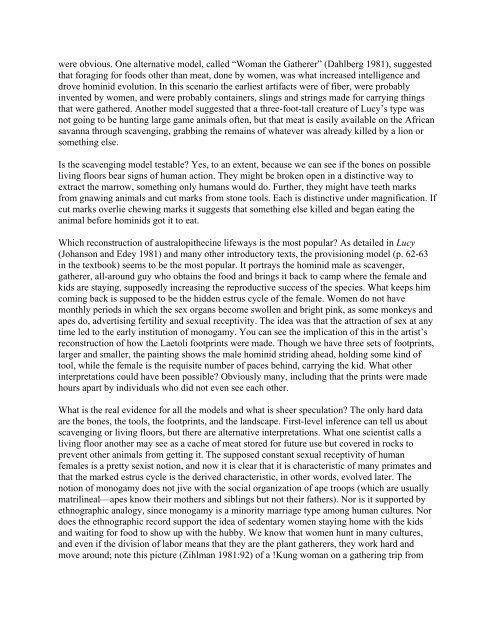INTRODUCTION TO ARCHAEOLOGY Nancy White - Touro Institute
INTRODUCTION TO ARCHAEOLOGY Nancy White - Touro Institute
INTRODUCTION TO ARCHAEOLOGY Nancy White - Touro Institute
Create successful ePaper yourself
Turn your PDF publications into a flip-book with our unique Google optimized e-Paper software.
were obvious. One alternative model, called “Woman the Gatherer” (Dahlberg 1981), suggested<br />
that foraging for foods other than meat, done by women, was what increased intelligence and<br />
drove hominid evolution. In this scenario the earliest artifacts were of fiber, were probably<br />
invented by women, and were probably containers, slings and strings made for carrying things<br />
that were gathered. Another model suggested that a three-foot-tall creature of Lucy’s type was<br />
not going to be hunting large game animals often, but that meat is easily available on the African<br />
savanna through scavenging, grabbing the remains of whatever was already killed by a lion or<br />
something else.<br />
Is the scavenging model testable? Yes, to an extent, because we can see if the bones on possible<br />
living floors bear signs of human action. They might be broken open in a distinctive way to<br />
extract the marrow, something only humans would do. Further, they might have teeth marks<br />
from gnawing animals and cut marks from stone tools. Each is distinctive under magnification. If<br />
cut marks overlie chewing marks it suggests that something else killed and began eating the<br />
animal before hominids got it to eat.<br />
Which reconstruction of australopithecine lifeways is the most popular? As detailed in Lucy<br />
(Johanson and Edey 1981) and many other introductory texts, the provisioning model (p. 62-63<br />
in the textbook) seems to be the most popular. It portrays the hominid male as scavenger,<br />
gatherer, all-around guy who obtains the food and brings it back to camp where the female and<br />
kids are staying, supposedly increasing the reproductive success of the species. What keeps him<br />
coming back is supposed to be the hidden estrus cycle of the female. Women do not have<br />
monthly periods in which the sex organs become swollen and bright pink, as some monkeys and<br />
apes do, advertising fertility and sexual receptivity. The idea was that the attraction of sex at any<br />
time led to the early institution of monogamy. You can see the implication of this in the artist’s<br />
reconstruction of how the Laetoli footprints were made. Though we have three sets of footprints,<br />
larger and smaller, the painting shows the male hominid striding ahead, holding some kind of<br />
tool, while the female is the requisite number of paces behind, carrying the kid. What other<br />
interpretations could have been possible? Obviously many, including that the prints were made<br />
hours apart by individuals who did not even see each other.<br />
What is the real evidence for all the models and what is sheer speculation? The only hard data<br />
are the bones, the tools, the footprints, and the landscape. First-level inference can tell us about<br />
scavenging or living floors, but there are alternative interpretations. What one scientist calls a<br />
living floor another may see as a cache of meat stored for future use but covered in rocks to<br />
prevent other animals from getting it. The supposed constant sexual receptivity of human<br />
females is a pretty sexist notion, and now it is clear that it is characteristic of many primates and<br />
that the marked estrus cycle is the derived characteristic, in other words, evolved later. The<br />
notion of monogamy does not jive with the social organization of ape troops (which are usually<br />
matrilineal—apes know their mothers and siblings but not their fathers). Nor is it supported by<br />
ethnographic analogy, since monogamy is a minority marriage type among human cultures. Nor<br />
does the ethnographic record support the idea of sedentary women staying home with the kids<br />
and waiting for food to show up with the hubby. We know that women hunt in many cultures,<br />
and even if the division of labor means that they are the plant gatherers, they work hard and<br />
move around; note this picture (Zihlman 1981:92) of a !Kung woman on a gathering trip from
















